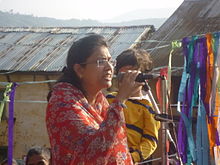Devyani Rana is the second daughter of Pashupati Shamsher Jang Bahadur Rana and Rani Usha Raje Scindia, daughter of Jiwaji Rao Scindia, the last maharaja of Gwalior, and the wife of Aishwarya Singh. News reports in 2001 suggested that the Crown Prince Dipendra of Nepal wanted to marry her, but his parents did not agree, and that the refusal was the cause of the Nepalese royal massacre, although other reasons have been suggested as well.
| Devyani Rana | |||||
|---|---|---|---|---|---|
 Devyani Rana during the election campaign of her father, 2013 | |||||
| Born | 1971 (age 52–53) | ||||
| Spouse |
Aishwarya Singh (m. 2007) | ||||
| Issue | Adidev Singh | ||||
| |||||
| House | |||||
| Father | Pashupati Shamsher JB Rana | ||||
| Mother | Rani Usha Raje Scindia | ||||
| Religion | Hinduism | ||||
Early life edit
Through her father, Devyani was born as a member of the Rana dynasty.[citation needed] Her mother, Usha Raje Scindia, is the daughter of Jivajirao Scindia, Maharaja of Gwalior.[1] She has one sibling, her older sister, Urvashi Khemka (née Urvashi Rajya Lakshmi).
Her paternal great-grandfather was Maharaja Mohan Shumsher JBR.
She attended Rishi Valley School in AP, Welham Girls' School, Dehradun, Ajmer; Lady Shriram College, Delhi and Kathmandu University (MA).[2]
Reports of Crown Prince Dipendra wanting to marry her edit
Dipendra was in England between 1987 and 1990, and his local guardian was Sir Jeremy Bagge, 7th Baronet,[3] whose son was also at Eton. Bagge's daughter was a friend of Devyani who was also studying in England.[4] Dipendra and Devyani met at the Bagges' Norfolk home, and Dipendra quickly fell in love with her and asked her to marry him. However, Dipendra's parents, and especially his mother Aishwarya Rajya Lakshmi Devi Shah (born Rana), opposed the marriage.[4][5]
According to an article in The New Yorker on 30 July 2001 and other published reports, the refusal of Dipendra's parents to consent to this marriage was the cause of the massacre of the royal family in Nepal.[6] However, a 2009 report based on an interview with his cousin Paras Shah suggested that there may have been other reasons as well,[7] with other theories alleging that Dipendra was unhappy with the country's shift from an absolute to a constitutional monarchy, and that too much power had been given away following the 1990 People's Movement.[6] A book, Maile Dekheko Darbar, by former Secretary to the King Birendra suggests that Dipendra may have had significant personality problems.[8]
Post massacre edit
Devyani Rana fled from India immediately after the royal massacre to escape media attention. In 2004, Rana obtained a second master's degree from the London School of Economics. She was reported to have been working for the United Nations Development Programme in India in 2012.[9] In 2014, she became Government and Corporate Affairs Director for India and the Asian subcontinent at Caterpillar Inc., and in 2021 she moved to Coca-Cola India as Vice President, Public Affairs, Communications and Sustainability for India and Southwest Asia.[10]
Personal life edit
On 23 February 2007, Rana married Yuvaraj Aishvarya Singh, the son of HH Maharaja Bhuvaneshwar Prasad Singh and HH Maharani Veena Singh of the erstwhile state of Singrauli. Aishwarya is the grandson of former Indian Human Resources Minister Arjun Singh, a royal from the state of Churhat Thikana.[11] The wedding took place at the Scindia Villa, New Delhi.[12]
In 2017, it was reported that Rana had become an active member of the Rastriya Prajatantra Party-Nepal (RPP-N).[13]
Rana has one son.
Portrayals edit
- Keerthi Reddy portrayed Devyani in the 2002 Indian film Super Star, which was loosely based on the massacre.[14]
- Indian actress Pracchi Mehta Shah portrayed the role of Devyani Rana in the third season of the documentary series Zero Hour, it showed a reconstruction of the massacre taken from surviving eyewitnesses.[15]
Ancestry edit
| Ancestors of Devyani Rana | |||||||||||||||||||||||||||||||||||||||||||||||||||||||||||||||||||||||||||||||||||||||||||||||||||||||||||||||||||||||||||||||||||||||||||||||||||||||||||||||||||||||||||||||||||||||||||||||||||||||||||||||||||||||||||||||||||||||||||||||||||||||||||||||||||||||||||||||||||||||||
|---|---|---|---|---|---|---|---|---|---|---|---|---|---|---|---|---|---|---|---|---|---|---|---|---|---|---|---|---|---|---|---|---|---|---|---|---|---|---|---|---|---|---|---|---|---|---|---|---|---|---|---|---|---|---|---|---|---|---|---|---|---|---|---|---|---|---|---|---|---|---|---|---|---|---|---|---|---|---|---|---|---|---|---|---|---|---|---|---|---|---|---|---|---|---|---|---|---|---|---|---|---|---|---|---|---|---|---|---|---|---|---|---|---|---|---|---|---|---|---|---|---|---|---|---|---|---|---|---|---|---|---|---|---|---|---|---|---|---|---|---|---|---|---|---|---|---|---|---|---|---|---|---|---|---|---|---|---|---|---|---|---|---|---|---|---|---|---|---|---|---|---|---|---|---|---|---|---|---|---|---|---|---|---|---|---|---|---|---|---|---|---|---|---|---|---|---|---|---|---|---|---|---|---|---|---|---|---|---|---|---|---|---|---|---|---|---|---|---|---|---|---|---|---|---|---|---|---|---|---|---|---|---|---|---|---|---|---|---|---|---|---|---|---|---|---|---|---|---|---|---|---|---|---|---|---|---|---|---|---|---|---|---|---|---|---|---|---|---|---|---|---|---|---|---|---|---|---|---|---|---|---|
| |||||||||||||||||||||||||||||||||||||||||||||||||||||||||||||||||||||||||||||||||||||||||||||||||||||||||||||||||||||||||||||||||||||||||||||||||||||||||||||||||||||||||||||||||||||||||||||||||||||||||||||||||||||||||||||||||||||||||||||||||||||||||||||||||||||||||||||||||||||||||
References edit
- ^ Soszynski, Henry. "CHURHAT". members.iinet.net.au. Retrieved 21 April 2018.
- ^ Pesta, Jesse (6 June 2001). "A Look at Two Players in Massacre Could Help Explain Nepalese Crisis". Wall Street Journal. Retrieved 5 April 2023.
- ^ Eton's royal connection BBC News, 2 June 2001
- ^ a b Dipendra and Devyani Nepali Times, 20 June 2001
- ^ Amy Willesee & Mark Whittaker (2004). Love & Death in Kathmandu A Strange Tale of Royal Murder, 1st U.S. ed. New York : St. Martin's Press, 2004. ISBN 1-84413-558-6 / 1-84413-558-6
- ^ a b Lisa Mullins (1 June 2011). "Why Nepal's Crown Prince Went on a Killing Spree". PRI. Archived from the original on 12 February 2020. Retrieved 17 October 2017.
- ^ Failed arms deal 'sparked' Nepal royal massacre, Thomas Bell, The Telegraph, 30 Mar 2009
- ^ Dipendra's troubled childhood Translated excerpt from book, Maile Dekheko Darbar by former Military Secretary to King Birendra Vivek Kumar Shah, Nepali Times, 27 MAY 2011
- ^ Indian royals occupy new place in society, Murali Krishnan, ABC< 9 Oct 2012
- ^ "Devyani Rajya Laxmi Rana". Coca-Cola India. Retrieved 20 November 2022.
- ^ CHURHAT (Thikana) Archived 2009-05-22 at the Wayback Machine
- ^ "Happy Marriage Devyani!". 23 February 2007. Retrieved 21 April 2018.
- ^ Nepal: 15 years after royal palace massacre, late prince’s fiancee eyes political role, Yubaraj Ghimire, February 12, 2017
- ^ "Super Star - is it really superstar v/s real star? People say 'No'..." viggy.com.
- ^ Padukone, Chaitanya (9 January 2007). "Pracchi's tragic take". DNA India.
- ^ Indian Rajputs
- ^ Indian Rajputs